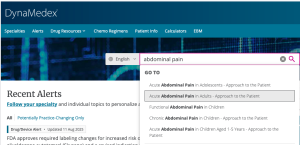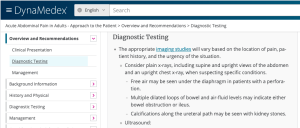Differential Diagnosis Tools
During today’s PBL session, your group listed some possible diagnoses in a differential diagnosis (DDx) list for upper abdominal (epigastric) pain. Should additional diagnoses be added to your list? Resources you can use to create a differential diagnosis list are AccessMedicine’s Diagnosaurus and DynaMedex.
DynaMedex is an online collection of frequently updated, peer-reviewed articles about clinical topics.
It includes articles of great interest to
- primary care physicians
- subspecialists (for instance, articles relevant to specialists in high risk obstetrics, pediatric cardiovascular surgeons, etc.)
- pharmacists and other allied health care professionals
This resource can also be used to locate a differential diagnosis list.
- Click here to open DynaMedex. Remember that you can find it on the library homepage in the Clinical Resources section of Resources.
- Type abdominal pain in the search box. Note that suggested topics appear automatically. Click on “Acute Abdominal Pain in adults.”

- To see a differential diagnosis list, scroll down the page to the “Clinical presentations characteristic for certain diseases include” section.

- When you critically appraise DynaMedex articles, be sure to look at the information about updating, authors and editors.

How does this information affect your comfort in relying on this resource as opposed to a textbook resource in AccessMedicine?
If you are curious about appropriate lab, imaging, and endoscopic testing:
- .Click on “Diagnostic Testing” tab on the left side of the topic page.

AccessMedicine also has a differential diagnosis (Ddx) tool for you to explore, Diagnosaurus.
To use this tool:
- Go to AccessMedicine
- Click on the “More…” link at the top right side of the site.
- Under “Quick Reference”, select “DDx”


